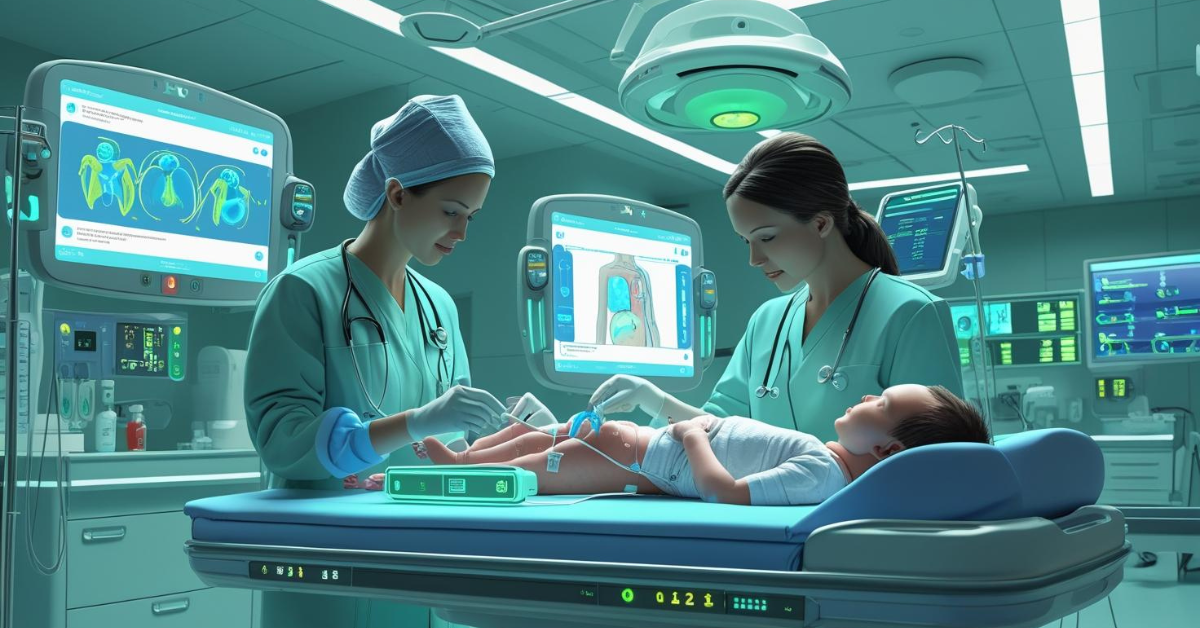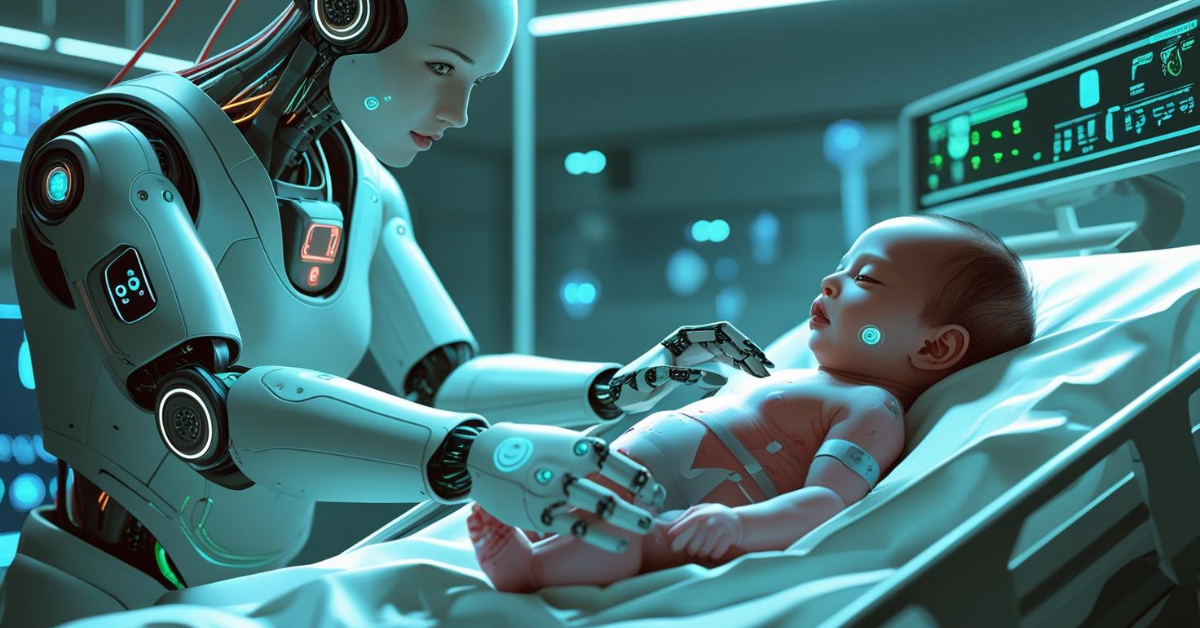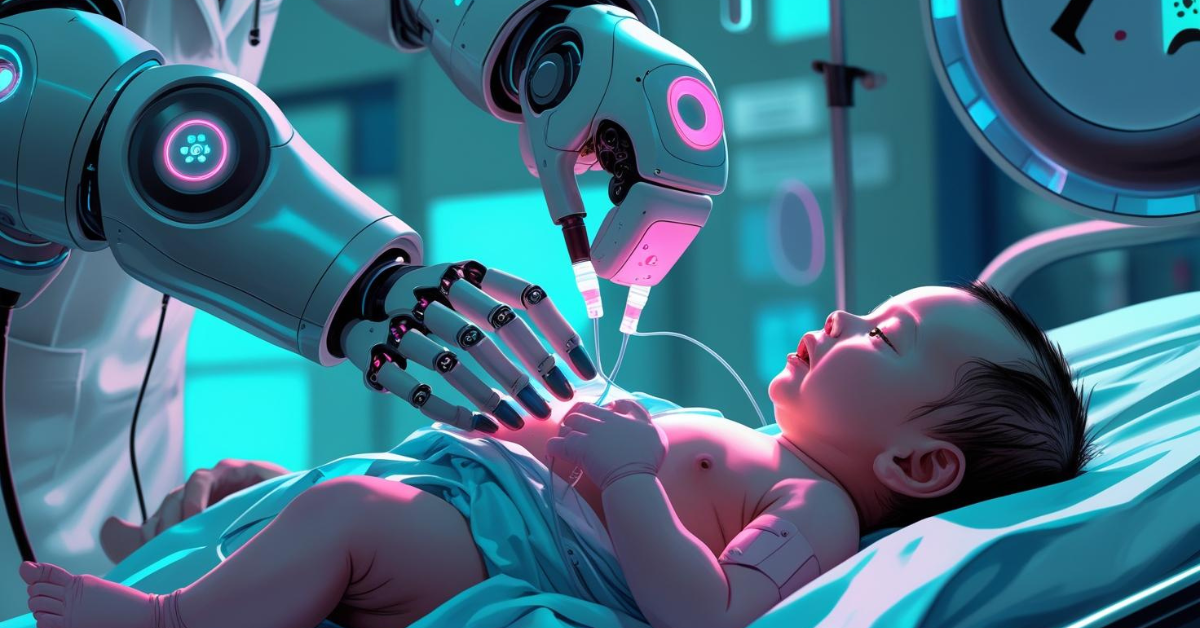The AI in Neonatal Resuscitation in 2026. 2026, AI is projected to play an increasingly important role in neonatal resuscitation. Potential applications include data analysis, predictive modeling, and even real-time support for procedures such as intubation.
The Use of AI in Neonatal Resuscitation in 2026
AI tools will analyze large amounts of neonatal data to identify subtle patterns and trends, potentially improving outcomes and optimizing treatment plans. While AI is still largely in development, its integration into neonatal intensive care units (NICUs) is becoming increasingly important. Researchers are investigating its potential to improve decision-making, personalize care, and increase patient safety.
Revolutionary Real-Time Decision Support Systems in Delivery Rooms
Neonatal resuscitation in 2026 has been converted thru the combination of state-of-the-art AI structures that offer instant, evidence-primarily based totally steerage throughout crucial moments whilst each 2nd determines consequences. These AI structures constantly examine a couple of facts streams such as fetal coronary heart fee styles throughout exertions, maternal fitness signs, gestational age parameters, and real-time physiological responses throughout shipping to expect resuscitation desires earlier than start occurs.
Advanced gadget gaining knowledge of algorithms educated on tens of thousands and thousands of shipping instances can perceive high-chance conditions with exceptional precision, alerting neonatal groups to ability headaches hours earlier than shipping begins. These structures examine complicated styles in fetal tracking facts, figuring out diffused signs of hypoxia, acidosis, or cardiovascular compromise that human interpretation may leave out throughout the depth of exertions management. The AI affords possibility exams for numerous resuscitation scenarios, allowing groups to put together suitable equipment, medications, and employees configurations tailor-made to predicted desires.
The integration of predictive analytics has revolutionized coaching protocols, with AI structures producing distinctive resuscitation coaching checklists primarily based totally on man or woman chance profiles. These structures recollect maternal elements which include diabetes, hypertension, contamination status, and medicine records along fetal traits such as envisioned weight, presentation, and intrauterine boom styles to create complete readiness plans that optimize consequences thru proactive coaching instead of reactive intervention.
Intelligent Physiological Monitoring and Automated Assessment Protocols
Contemporary neonatal resuscitation makes use of superior sensor technology that offer continuous, non-invasive tracking of essential physiological parameters from the instant of shipping. AI-powered tracking structures song coronary heart rate, respiration attempt, oxygen saturation, blood pressure, temperature, and neurological responses via state-of-the-art sensors incorporated into warming tables, air flow equipment, and wearable tracking gadgets designed particularly for new child physiology.
These sensible tracking structures make use of pc imaginative and prescient era to evaluate color, tone, and respiration attempt with extra precision and consistency than conventional human commentary methods. High-decision cameras with specialized lights structures seize diffused adjustments in pores and skin color, locate micro-actions indicating respiration attempt, and examine posture and reflexes to offer goal Apgar scoring that gets rid of inter-observer variability and guarantees steady evaluation requirements throughout all shipping settings.
Real-time physiological facts integration permits AI structures to constantly calculate resuscitation effectiveness scores, supplying instantaneously remarks approximately intervention fulfillment and recommending protocol changes primarily based totally on character affected person responses. These structures can locate superb traits indicating success resuscitation in advance than conventional methods, allowing groups to hold powerful interventions with self-assurance at the same time as figuring out loss of development that calls for escalation to greater extensive interventions.
Precision Ventilation Management through Machine Learning Algorithms
Mechanical air flow for newborns requiring respiration help has been revolutionized via AI structures that routinely alter ventilator settings primarily based totally on non-stop evaluation of respiration mechanics, fuel line change efficiency, and cardiovascular responses. These smart air flow structures make use of superior algorithms that do not forget gestational age, delivery weight, underlying pathophysiology, and real-time affected person responses to optimize tidal volumes, respiration rates, high-quality end-expiratory stress levels, and oxygen concentrations.
Machine getting to know algorithms educated on large datasets of a hit air flow techniques can expect most beneficial air flow parameters for character sufferers inside seconds of starting up help. These structures constantly examine chest wall motion patterns, airway stress curves, carbon dioxide removal rates, and oxygen saturation tendencies to make micro-modifications that optimize fuel line change even as minimizing lung damage dangers related to mechanical air flow in immature lung tissue.
Advanced ventilators geared up with AI competencies can routinely wean respiration help as affected person situations improve, regularly lowering help even as tracking for symptoms and symptoms of respiration misery that could imply untimely weaning attempts. This smart weaning procedure has extensively decreased ventilator-related complications, shortened in depth care stays, and advanced long-time period respiration consequences for untimely babies requiring prolonged ventilator help.
Automated Drug Calculation and Administration Safety Systems
Medication management at some point of neonatal resuscitation has been more suitable via AI structures that routinely calculate unique drug dosages primarily based totally on predicted or measured delivery weights, gestational ages, and unique scientific indications. These structures do away with calculation mistakes that may be life-threatening in emergency situations, supplying on the spontaneous dosage pointers for epinephrine, extent expanders, sodium bicarbonate, and different resuscitation medicinal drugs normally required at some point of shipping room emergencies.
Smart infusion pumps included with AI structures can routinely put together and administer medicinal drugs at exactly calculated costs even as constantly tracking affected person responses to hit upon effectiveness or unfavorable reactions. These structures preserve precise logs of all medicinal drug management timing, dosages, and affected person responses, supplying complete documentation that helps exceptional development efforts and medico legal necessities even as lowering documentation burdens on scientific groups centered on affected person care.
Advanced protection protocols embedded inside AI structures offer more than one verification assessments earlier than medicinal drug management, evaluating calculated dosages in opposition to mounted protection limits, checking for ability drug interactions, and verifying suitable routes of management primarily based totally on affected person length and vascular get entry to availability. These protection structures have honestly removed medicinal drug mistakes at some point of neonatal resuscitation procedures.
Integrated Team Communication and Coordination Platforms
AI-powered communique structures have converted coordination amongst multidisciplinary resuscitation groups via clever workflow control that routinely assigns roles, coordinates activities, and allows seamless statistics sharing throughout excessive-strain emergency situations. These structures make use of voice reputation generation to seize spoken communications, convert them to dependent documentation, and distribute applicable statistics to suitable crew participants in real-time.
Advanced coordination structures can expect staffing desires primarily based totally on predicted resuscitation complexity, routinely summoning extra professionals along with neonatologists, pediatric surgeons, or delivery groups whilst AI algorithms suggest excessive possibility of requiring specialized interventions. These structures keep situational consciousness for all crew participants via heads-up displays, cellular tool notifications, and ambient communique structures that make certain all people has get right of entry to contemporary affected person popularity and intervention progress.
Real-time overall performance comments structures examine crew dynamics, communique patterns, and intervention timing to offer on the spot education hints that optimize crew effectiveness throughout ongoing resuscitation efforts. These structures can perceive communiqué breakdowns, endorse function clarifications, and advocate system upgrades that beautify coordination and decrease mistakes throughout important care delivery.
Advanced Neurological Monitoring and Neuroprotection Strategies
Brain tracking for the duration of neonatal resuscitation has been revolutionized thru AI-powered neurological evaluation structures that make use of superior electroencephalography, near-infrared spectroscopy, and ultrasound technology to assess mind feature and locate damage dangers in real-time. These structures can pick out seizure activity, examine cerebral blood go with the drift patterns, and locate symptoms and symptoms of hypoxic-ischemic damage inside mins of birth.
Machine getting to know algorithms skilled on hundreds of neurological consequences can expect long-time period developmental dangers primarily based totally on early tracking information, permitting implementation of neuroprotective interventions along with healing hypothermia, optimized air flow strategies, and centered blood stress control designed to limit mind damage for the duration of the essential length following transport room resuscitation.
Continuous neurological tracking structures offer trending information that enables medical groups regulate interventions to optimize mind perfusion, save you secondary damage from hypoxia or hypotension, and pick out sufferers who might gain from specialized neurological care or switch to centers geared up with superior neuroprotective capabilities.
Personalized Resuscitation Protocols Based on Individual Risk Profiles
AI structures have enabled the improvement of distinctly individualized resuscitation protocols that do not forget precise affected person traits which includes genetic elements, maternal fitness conditions, intrauterine exposures, and precise pathophysiological tactics affecting person newborns. These personalized methods optimize intervention choice and timing primarily based totally on proof from comparable instances at the same time as adapting to real-time affected person responses in the course of resuscitation procedures.
Advanced phenotyping algorithms examine more than one facts reassets to create complete affected person profiles that manual decision-making at some stage in resuscitation efforts. These structures can perceive genetic editions affecting drug metabolism, are expecting responses to precise interventions, and suggest opportunity methods whilst fashionable protocols can be much less powerful for person patients.
Precision remedy methods in neonatal resuscitation now encompass attention of pharmacogenomics elements that have an impact on medicinal drug effectiveness, air flow techniques tailor-made to precise lung improvement patterns, and cardiovascular assist protocols tailored to person cardiac anatomy and characteristic traits recognized thru speedy diagnostic imaging completed in the course of transport room care.
Quality Improvement Through Comprehensive Data Analytics and Outcomes Tracking
AI structures have revolutionized first-class development efforts in neonatal resuscitation thru complete records collection, analysis, and effects monitoring that offer targeted insights into intervention effectiveness, crew performance, and long-time period affected person effects. These structures routinely seize all factors of resuscitation care, growing targeted case critiques that perceive possibilities for development and music development over time.
Advanced analytics systems can perceive diffused styles in care shipping that correlate with advanced effects, allowing proof-primarily based totally refinements to protocols, education programs, and useful resource allocation decisions. These structures examine hundreds of resuscitation instances to perceive high-satisfactory practices, come across rising trends, and offer benchmarking records that helps non-stop development efforts.
Machine studying algorithms constantly replace resuscitation protocols primarily based totally on effects records, incorporating new proof and refining suggestions to mirror contemporary high-satisfactory practices. This dynamic technique guarantees that care protocols continue to be contemporary with evolving scientific know-how even as adapting to neighborhood populace traits and institutional capabilities.
Integration with Maternal Care and Perinatal Risk Assessment
Contemporary AI structures offer seamless integration among maternal care tracking and neonatal resuscitation practise via complete perinatal danger evaluation structures that examine maternal fitness data, exertions development patterns, and fetal tracking statistics to are expecting transport effects and optimize practise for capacity resuscitation needs.
Advanced predictive modeling considers complicated interactions among maternal situations which include preeclampsia, diabetes, infections, and medicine exposures along fetal traits together with increase patterns, amniotic fluid volumes, and placental characteristic signs to generate complete danger profiles that manual transport making plans and resuscitation crew practise.
These included structures allow proactive in place of reactive processes to high-danger deliveries, with AI tips for most beneficial timing of deliveries, suitable degree of care facilities, and specialized crew configurations that maximize chance of a hit effects while resuscitation will become necessary.
Training and Simulation Enhancement through Virtual Reality and AI Coaching
Medical training and schooling for neonatal resuscitation has been converted thru AI-powered simulation structures that offer realistic, high-constancy schooling reports the use of digital fact technology and smart training algorithms. These structures create immersive schooling environments wherein healthcare vendors can exercise complicated resuscitation eventualities with instant comments and overall performance analysis.
Advanced simulation systems make use of AI to generate numerous case eventualities primarily based totally on actual affected person data, offering freshmen with publicity to uncommon conditions, complicated decision-making situations, and difficult group dynamics in secure getting to know environments. These structures adapt issue degrees primarily based totally on learner overall performance, offering personalized schooling reports that optimize ability improvement and know-how retention.
Intelligent training structures examine trainee overall performance in actual-time, offering instant comments approximately decision-making speed, intervention accuracy, communique effectiveness, and group coordination skills. These structures can discover precise regions requiring development and advocate focused getting to know sports that cope with person know-how gaps and ability deficiencies.
Read More:
https://nurseseducator.com/didactic-and-dialectic-teaching-rationale-for-team-based-learning/
https://nurseseducator.com/high-fidelity-simulation-use-in-nursing-education/
First NCLEX Exam Center In Pakistan From Lahore (Mall of Lahore) to the Global Nursing
Categories of Journals: W, X, Y and Z Category Journal In Nursing Education
AI in Healthcare Content Creation: A Double-Edged Sword and Scary
Social Links:
https://www.facebook.com/nurseseducator/
https://www.instagram.com/nurseseducator/
https://www.pinterest.com/NursesEducator/
https://www.linkedin.com/in/nurseseducator/
https://www.researchgate.net/profile/Afza-Lal-Din
https://scholar.google.com/citations?hl=en&user=F0XY9vQAAAAJ


